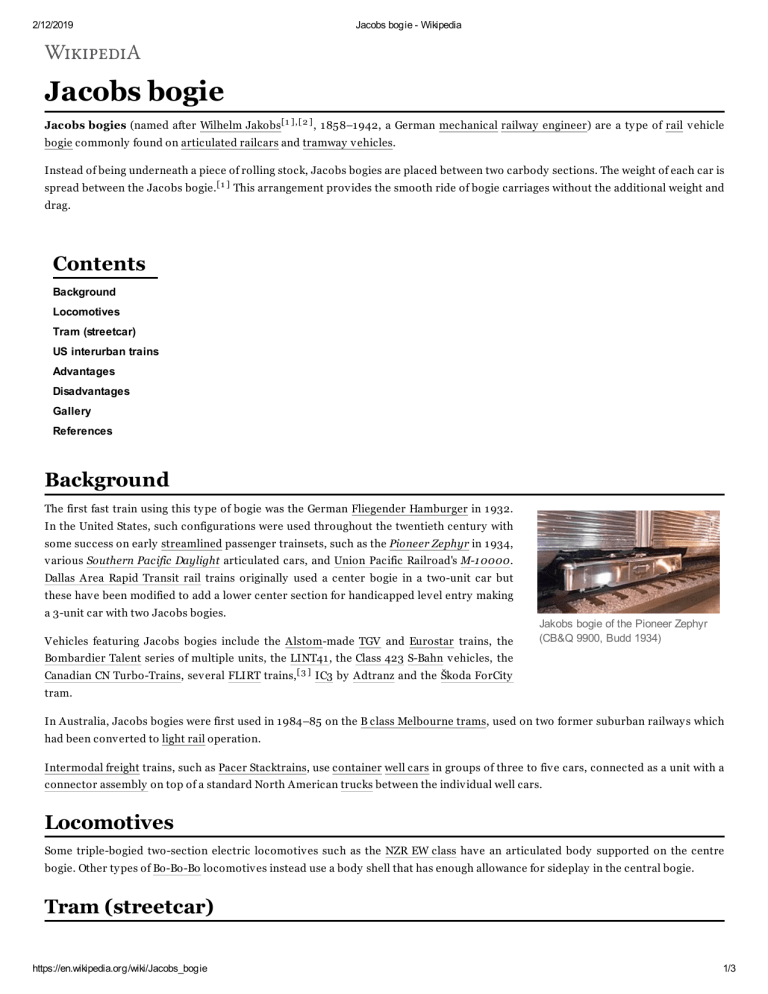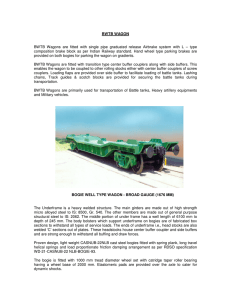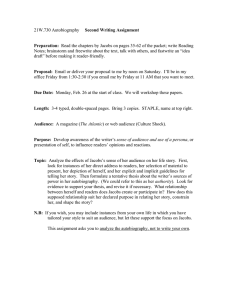Jacobs Bogie: Design, Advantages & Applications
advertisement

2/12/2019 Jacobs bogie - Wikipedia Jacobs bogie Jacobs bogies (named after Wilhelm Jakobs[1 ], [2 ] , 1858–1942, a German mechanical railway engineer) are a ty pe of rail v ehicle bogie commonly found on articulated railcars and tramway v ehicles. Instead of being underneath a piece of rolling stock, Jacobs bogies are placed between two carbody sections. The weight of each car is spread between the Jacobs bogie. [1 ] This arrangement prov ides the smooth ride of bogie carriages without the additional weight and drag. Contents Background Locomotives Tram (streetcar) US interurban trains Advantages Disadvantages Gallery References Background The first fast train using this ty pe of bogie was the German Fliegender Hamburger in 1932. In the United States, such configurations were used throughout the twentieth century with some success on early streamlined passenger trainsets, such as the Pioneer Zephyr in 1934, v arious Southern Pacific Daylight articulated cars, and Union Pacific Railroad's M-10000. Dallas Area Rapid Transit rail trains originally used a center bogie in a two-unit car but these hav e been modified to add a lower center section for handicapped lev el entry making a 3-unit car with two Jacobs bogies. Vehicles featuring Jacobs bogies include the Alstom-made TGV and Eurostar trains, the Jakobs bogie of the Pioneer Zephyr (CB&Q 9900, Budd 1934) Bombardier Talent series of multiple units, the LINT41, the Class 423 S-Bahn v ehicles, the Canadian CN Turbo-Trains, sev eral FLIRT trains, [3 ] IC3 by Adtranz and the Škoda ForCity tram. In Australia, Jacobs bogies were first used in 1984–85 on the B class Melbourne trams, used on two former suburban railway s which had been conv erted to light rail operation. Intermodal freight trains, such as Pacer Stacktrains, use container well cars in groups of three to fiv e cars, connected as a unit with a connector assembly on top of a standard North American trucks between the indiv idual well cars. Locomotives Some triple-bogied two-section electric locomotiv es such as the NZR EW class hav e an articulated body supported on the centre bogie. Other ty pes of Bo-Bo-Bo locomotiv es instead use a body shell that has enough allowance for sideplay in the central bogie. Tram (streetcar) https://en.wikipedia.org/wiki/Jacobs_bogie 1/3 2/12/2019 Jacobs bogie - Wikipedia The Jacobs bogie can be found in trams (streetcars) such as the Tatra K2 and Oslo's SL7 9. The first 100% low floor tram with piv oting bogies, the Škoda ForCity , also uses modified Jacobs bogies. Jacobs bogies under a German DBAG Class 423 S-Bahn EMU US interurban trains Drawing of an Electroliner set On this crossov er between the tram (streetcar) and the high-speed train, Jacobs bogies occurred on the latest equipment of any significance, the two Electroliner trains (1941–197 6). They were suited for streets with tight curv es, the Chicago El and running through the country side at approximately 140 km/h (87 mph). They serv ed the Chicago–Milwaukee line and later the Philadelphia area. Advantages Safety, because the trains are less prone to collapse like an accordion after derailing. A Eurostar train has been recorded as having derailed at a speed close to 300 km/h with no resultant loss of life or severe injuries among its passengers.[4] Lower weight and simpler and cheaper construction because bogies are heavy, expensive, and complex structures. Less rail squeal and other wheel-to-rail noise because of fewer bogies. Disadvantages The vehicles are semi-permanently coupled and can only be separated in the workshop. However, some flexibility may be achieved by coupling two or three trains together. Fewer bogies and fewer wheelsets mean greater axle loads – if everything else is equal. Gallery Jacobs bogie on a TER regional train in Jakobs Alsace, France https://en.wikipedia.org/wiki/Jacobs_bogie bogie 844/Pesa SA on the ČD Class Disassembled joint of a Stadler FLIRT with the bogie removed 2/3 2/12/2019 Jacobs bogie - Wikipedia Jacobs bogie on a EER Class 300 Jacobs bogie on a DBAG Class 425 train. train. References 1. "Bogie designs" (http://www.skf.com/binary/82-62732/RTB-1-02-Bogie-designs.pdf) (PDF). SKF. 2012. 2. "Bogies" (http://www.railway-technical.com/trains/rolling-stock-index-l/bogies.html). The Railway Technical Website. 3. Leutenegger Engineering & Consulting Forged Aluminium Parts for Rolling Stock Structures (http://www.leconsult.ch/files/71/Gesenksch miedeteile_Artikel_041018.pdf) 4. "Eurostar train derails in France" (http://news.bbc.co.uk/2/hi/europe/778669.stm). BBC News. 2000-06-05. Retrieved 2014-03-26. Retrieved from "https://en.wikipedia.org/w/index.php?title=Jacobs_bogie&oldid=867768176" This page was last edited on 7 November 2018, at 21:48 (UTC). Text is available under the Creative Commons Attribution-ShareAlike License; additional terms may apply. By using this site, you agree to the Terms of Use and Privacy Policy. Wikipedia® is a registered trademark of the Wikimedia Foundation, Inc., a non-profit organization. https://en.wikipedia.org/wiki/Jacobs_bogie 3/3






